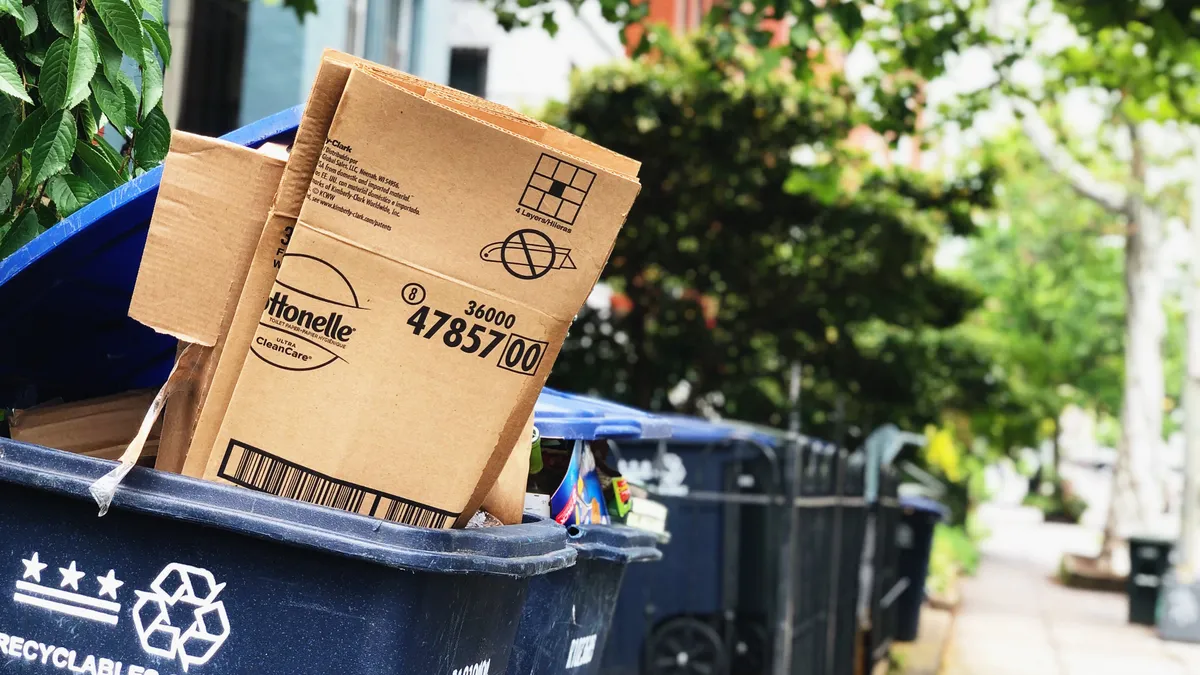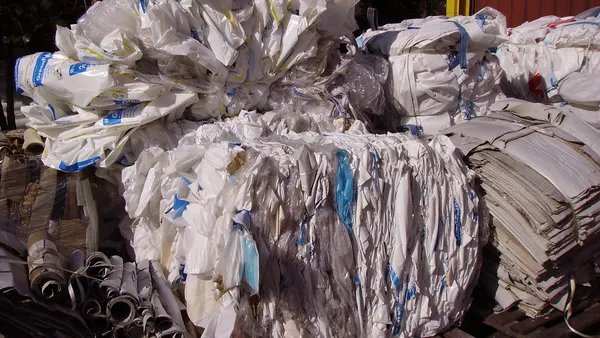Dive Brief:
- An uptick in reliance on e-commerce and a broader emphasis on packaging during the coronavirus pandemic could have long-term implications for the corrugated box industry. Markets for container paperboard — used to make corrugated boxes — have proven resilient, and experts believe trends will likely continue into the short term, perhaps even permanently.
- That could prove to be a bright spot for the recycling sector even as the recession deepens. But that success comes along with new challenges, including a volume shift from commercial to residential, resulting in higher contamination rates and lower volumes overall.
- Rachel Kenyon, senior vice president for the Fibre Box Association, told Waste Dive proper recycling has become more critical due to pandemic trends. "When commercial collections stalled because of COVID-19 shutdowns, the corrugated industry recognized the need to encourage greater residential recycling," she said, adding the industry "needs clean, dry corrugated to ensure we maintain our balanced system."
Dive Insight:
Demand for corrugated boxes has grown slightly in the United States even as the broader market has taken a hit. According to the American Forest and Paper Association (AF&PA), U.S. containerboard production increased 1% in June 2020 year-over-year, with output rising 5% for the first half of the year. Production of containerboard for exports was also up 5% in June and 34% year-to-date.
Corrugated box shipments increased 9% in March as compared to 2019, Kenyon said. "Then as businesses began to reopen, box shipments for April and May fell in line with previous calendar years and then increased slightly again in June," she said. "Year-to-date box shipments have grown by 1.4% during the first half of this year."
Experts attribute those numbers to an uptick in packaging during the pandemic, which has drawn attention to residential recycling. The U.S. EPA released a video in May specifically encouraging the recycling of cardboard boxes and recyclers have similarly emphasized the importance of capturing material for manufacturing needs.
Seeking increased feedstock from residential sources, AF&PA released industry guidance in mid-July stating grease and cheese on pizza boxes should not be a hurdle in recycling. The association identified packaging from residential collection as a major paper recycling opportunity even prior to the pandemic, Heidi Brock, AF&PA president and CEO, told Waste Dive in a statement.
"Now that consumers are staying home, they are more frequently ordering items for delivery, like pizza and e-commerce shipments," Brock said. "As more boxes arrive at home, it’s more important than ever that consumers are given clear communication about what to recycle."
Toby Earnest, director of recycling for DS Smith's North America operations, told Waste Dive in early July that the pandemic has hindered access to fiber feedstock due to MRF closures and other issues, but said e-commerce has bolstered the packaging company's trajectory.
While e-commerce has been on the rise for several years, Earnest said the pandemic offered the sector a "tremendous burst." DS Smith initially saw two to three times the numbers of orders it typically receives.
Those numbers have now settled slightly, but Earnest thinks some trends could become permanent, with implications for recycled content, which is used by over 90% of DS Smith mills. "There's a pretty healthy appetite for recycled fiber and what we use in our products," Earnest said.
Financially, the packaging sector has taken a hit alongside others, given the decline of industrial and commercial volumes. But the uptick in demand for packaging and sanitation products have offered some balance, likely into the future. A new national survey by DS Smith found 85% of U.S. customers say they will continue to shop online at the same rate or more when the pandemic winds down.
Chaz Miller, a former policy director with the National Waste and Recycling Association, told Waste Dive it is still hard to predict short-term and long-term trends in an unprecedented year. "I think you're going to continue to see more corrugated [material] residentially," he said. "I don't think you're going to see more commercially until stores reopen and start operating the way they were before."
That means ongoing pressure to reduce residential contamination. Corrugated boxes contain on average around 50% recycled content, according to Kenyon, and the need for clean feedstock may incentivize more efforts around education and outreach.
"The corrugated industry relies heavily on a balanced system of both new and used fibers to make corrugated packaging," she said.
Concerns aside, Miller pointed to AF&PA's pizza box announcement as a signal about potential industry needs around residential recycling, even given contamination levels. He also highlighted the staying power of corrugated boxes more broadly, noting they endured in recent years before the pandemic — even as materials like printing and writing paper faced decline and flexible plastic packaging has become more popular.
"I think the industry is always looking to lower its energy costs and its material costs," he said. "Corrugated has survived, however."










